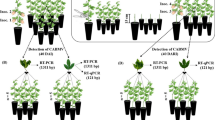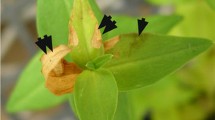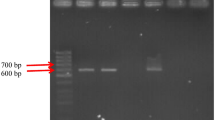Abstract
Passion fruit green spot disease was first identified in 1997 after a severe outbreak at Vera Cruz County, state of São Paulo, Brazil. Mature yellow fruits of Passiflora edulis Simms f. flavicarpa Degener showed characteristic green spots, 2–5 mm in diameter and patches of green tissues were present on senescent leaves. The devastating effect to passion flower is caused by necrotic lesions that encircle the stems and kill the plant. In severe cases, entire orchards of a few hectares in size have been completely destroyed. The disease was always preceded by heavy infestations of Brevipalpus phoenicis (Geijskes) (Acari: Tenuipalpidae). Transmission electron microscopy of affected tissues (fruits, leaves, and stems) consistently revealed the presence of short, bacilliform particles (50–70 nm × 100–120 nm) in the cisternae of the endoplasmic reticulum, as well as the presence of a dense viroplasm in the cytoplasm. This cytopathic effect has been found in several other Brevipalpus-transmitted or associated viruses and is classified as a cytoplasmic type of disease. Experimental reproduction of the leaf and stem symptoms was achieved by transferring B. phoenicis collected from affected field passion flower plants onto healthy plants. The evidence supports a viral etiology for the disease and the agent was named passion fruit green spot virus. Its relationship with other B. phoenicis related viruses continues to be studied. The disease was also found in the Brazilian states of Bahia, Sergipe, Rondonia, Minas Gerais, Rio de Janeiro, and in the Federal District. Use of one or more of the following acaricides (hexythiazox, fenbutatin-oxide, propargite, quinomethionate, or dicofol) has significantly reduced the incidence of the disease.
Similar content being viewed by others
References
Chagas, C.M., Colariccio, A., Miyai, T. and Galleti, S.R. 2000. Novos aspectos ultraestruturais da pinta verde do maracujá. Summa Phytopathol. 26: 131.
Colariccio, A., Lovisolo, O., Chagas, C.M., Galletti, S.R., Rossetti, V. and Kitajima, E.W. 1995. Mechanical transmission and ultrastructural aspects of citrus leprosis disease. Fitopatol. Bras. 20: 208–213.
Freitas-Astua, J., Rezende, J.A.M. and Kitajima, E.W. 1999. Incidence of orchid viruses in the state of São Paulo, Brazil. Fitopatol. Bras. 24: 125–130.
Kitajima, E.W. 2001. Bevipalpus-mite transmitted plant viruses. In: Proc. 11th Congr. Mediterr. Union Phytopathol. and 3rd Congr. Soc. Portuguesa de Fitopatol., Évora, Portugal, 17–20 September 2001, pp. 36–39.
Kitajima, E.W. and Crestani, O. 1985. Association of a rhabdovirus with passion fruit vein clearing in Brazil. Fitopatol. Bras. 10: 681–688.
Kitajima, E.W. and Moraes, G.J. 2000. Manchas cloróticas em Clerodendron x speciosum e mancha anular em Solanum violaefolium associadas a efeitos citopáticos similares aos dos vírus transmitido pelo ácaro Brevipalpus. Summa Phytopathol. 26: 133–134 (abstract).
Kitajima, E.W., Rosillo, M.A., Portillo, M.M., Müller, G.W. and Costa, A.S. 1974. Microscopia eletrônica de tecidos foliares de laranjeiras infectadas pela lepra explosiva da Argentina. Fitopatologia (Lima) 9: 55–56.
Kitajima, E.W., Rezende, J.A.M., Rodrigues, J.C.V., Chiavegato, L.G., Piza Jr., C.T. and Morozini, W. 1997. Green spot of passion fruit, a possible viral disease associated with infestation by the mite Brevipalpus phoenicis. Fitopatol. Bras. 22: 555–559.
Kitajima, E.W., Novaes, Q.S., Rezende, J.A.M. and Morais, G.J. 1999a. Short rhabdovirus-like particles and a caulimovirus in Hibiscus rosa-sinensis with green spot. Abstr. Scandem '99, Bergen, 2–6 June 1999, pp. 63–64.
Kitajima, E.W., Pedrazzoli, D.S., Novaes, Q.S., Gioria, R., Rezende, J.A.M., Moraes, G.J. and Rodrigues, J.C.V. 1999b. Ivy green spot and Schefflera ringspot: two additional cases of plant diseases caused by citrus leprosis type virus. Virus Rev. Res. 4(1): 148–149.
Kitajima, E.W., Chagas, C.M. and Rodrigues, J.C.V. 2003. Brevipalpus-transmitted plant virus and virus-like diseases: cytopathology and reports of some recent cases. Exp. Appl. Acarol. 30: 135–160.
Lima, M.L.R.Z.C., Costa Lima No, V. and Souza, V.B.V. 1991. The causal agent of the Ligustrum ringspot disease. Phytopathology 81: 1216.
Morozini, W., Kitajima, E.W., Rezende, J.A.M., Rodrigues, J.C.V. and Piza Jr., C.T. 1997. A pinta verde do maracujazeiro. CATI, Campinas, 7 pp.
Musumecci, M.R. and Rossetti, V. 1963. Transmissão de sintomas de leprose dos citros pelo ácaro Brevipalpus phoenicis. Ciência e Cultura 15(3): 228.
Nogueira, N.L., Rodrigues, J.C.V. and Rossi, M.L. 2001. Partículas semelhantes a rhabdovirus associadas a sintomas de mancha verde em folhas de manacá (Brunfelsia sp.). Fitopatol. Bras. 26: 513.
Rodrigues, J.C.V. 1995. —Leprose dos citros: cito-histopatologia, transmissibilidade e relação com o vetor Brevipalpus phoenicis Geijskes (Acari: Tenuipalpidae). MS Dissextation, Piracicaba, Universidade de São Paulo, Cena, 79 pp.
Rodrigues, J.C.V., Nogueira, N.L. and Freitas, D.S. 1995. Ringspot of Ligustrum lucidum Aiton, a new disease transmitted by Brevipalpus phoenicis G. (Acari: Tenuipalpidae) in Brazil. Fitopatol. Bras. 20: 292.
Rodrigues, J.C.V., Kitajima, E.W., Childers, C.C. and Chagas, C.M. 2003. Citrus leprosis virus vectored by Brevipalpus phoenicis (Acari: Tenuipalpidae) in citrus in Brazil. Exp. Appl. Acarol. 30: 161–179.
Santos Fo, H.P., Chagas, C.M., Miya, T. and Barbosa, C.J. 1999. Identification of passion fruit green spot in Bahia State. Virus Rev. Res. 4(1): 150–151.
Takatsu, A., Pereira, A.F. and Silva, J.R. 2000. Levantamento de doenças do maracujazeiro no Triângulo Mineiro. Fitopatol. Bras. 25: 332–333.
Author information
Authors and Affiliations
Corresponding author
Rights and permissions
About this article
Cite this article
Kitajima, E., Rezende, J. & Rodrigues, J. Passion Fruit Green Spot Virus Vectored by Brevipalpus phoenicis (Acari: Tenuipalpidae) on Passion Fruit in Brazil. Exp Appl Acarol 30, 225–231 (2003). https://doi.org/10.1023/B:APPA.0000006551.74604.84
Issue Date:
DOI: https://doi.org/10.1023/B:APPA.0000006551.74604.84




